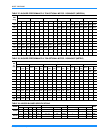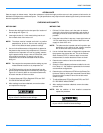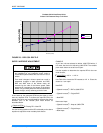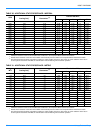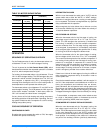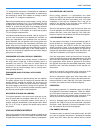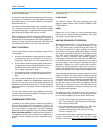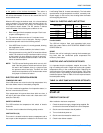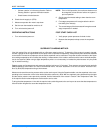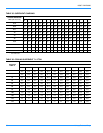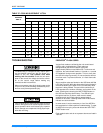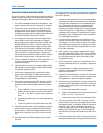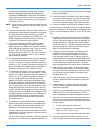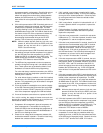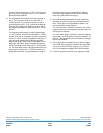
66307-YIM-B-0606
Unitary Products Group 43
low-pressure switch, or freezestat. Check for 24 volts at
the HPS2, LPS2, and FS2 terminals of the UCB. If a
switch has opened, there should be a voltage potential
between the UCB terminals, e.g. if LPS2 has opened,
there will be 24 volts of potential between the LPS2 ter-
minals.
9. If 24 volts is present at the UCB Y2 terminal and none of
the protection switches have opened, the UCB may have
locked out the compressor for repeat trips. The UCB
should be flashing a code. If not, press and release the
ALARMS button on the UCB. The UCB will flash the last
five alarms on the LED. If the compressor is locked out,
remove any call for cooling at the thermostat or by
disconnecting the thermostat wiring at the Y2 UCB
terminal. This will reset any compressor lock outs.
NOTE: While the above step will reset any lock outs, com-
pressor #1 will be held off for the ASCD, and com-
pressor #2 may be held off for a portion of the
ASCD. See the next step.
10. If 24 volts is present at the UCB Y2 terminal and none of
the switches are open and the compressor is not locked
out, the UCB may have the compressor in an ASCD.
Check the LED for an indication of an ASCD cycle. The
ASCD should time out within 5 minutes. Press and
release the TEST button to reset all ASCDs.
11. The UCB can be programmed to lock out compressor
operation during free cooling and in low ambient condi-
tions. These options are not enabled by default. Local
distributors can test the UCB for this programming.
For units with factory installed economizers, the UCB is
programmed to lock out compressor operation when the
LAS set point is reached.
For units without factory installed or with field installed
economizers, the UCB allows compressor operation all
the time. This programming can be checked or changed
by the local distributor.
12. If none of the above corrected the error, test the integrity
of the UCB. Disconnect the C2 terminal wire and jumper
it to the Y2 terminal. DO NOT jump the Y2 to C2 termi-
nals. If the compressor engages, the UCB has faulted.
13. If none of the above correct the error, replace the UCB.
On a call for cooling, the supply air blower motor and com-
pressor #2 are operating but compressor #1 is not (the room
thermostat fan switch is in the “AUTO” position).
1. Compressor #2 is energized in place of compressor #1
when compressor #1 is unavailable for cooling calls.
Check the UCB for alarms indicating that compressor #1
is locked out. Press and release the ALARMS button if
the LED is not flashing an alarm.
2. Check for line voltage at the compressor contactor, M1,
and that the contactor is pulled in. Check for loose wiring
between the contactor and the compressor.
3. If M1 is pulled in and voltage is supplied at M1, lightly
touch the compressor housing. If it is hot, the compres-
sor may be off on inherent protection. Cancel any calls
for cooling and wait for the internal overload to reset.
Test again when cool.
4. If M1 is not pulled in, check for 24 volts at the M1 coil. If
24 volts is present and M1 is not pulled in, replace the
contactor.
5. Failing the above, if voltage is supplied at M1, M1 is
pulled in, and the compressor still does not operate,
replace the compressor.
6. If 24 volts is not present at M1, check for 24 volts at the
UCB terminal, C1. If 24 volts is present, check for loose
wiring between C1 and the compressor contactor.
7. If 24 volts is not present at the C1 terminal, check for 24
volts from the room thermostat at the UCB Y1 terminal.
If 24 volts are not present at the UCB Y1 terminal, the
UCB may have faulted. Check for 24 volts at the Y1
ECON terminal. If 24 volts is not present at Y1 “ECON”,
the UCB has faulted. The UCB should de-energize all
compressors on a loss of call for the first stage of cool-
ing, i.e. a loss if 24 volts at the Y1 terminal.
8. If 24 volts are present at the UCB Y1 terminal, the com-
pressor may be out due to an open high-pressure switch,
low-pressure switch, or freezestat. Check for 24 volts at
the HPS1, LPS1, and FS1 terminals of the UCB. If a
switch has opened, there should be a voltage potential
between the UCB terminals, e.g. if LPS1 has opened,
there will be a 24-volt potential between the LPS1 termi-
nals.
9. If 24 volts is present at the UCB Y1 terminal and none of
the protection switches have opened, the UCB may have
locked out the compressor for repeat trips. The UCB
should be flashing a code. If not, press and release the
ALARMS button on the UCB. The UCB will flash the last
five alarms on the LED. If the compressor is locked out,
remove any call for cooling. This will reset any compres-
sor lock outs.
NOTE: While the above step will reset any lock outs, com-
pressor #2 will be held off for the ASCD, and com-
pressor #1 may be held off for a portion of the
ASCD. See the next step.
10. If 24 volts is present at the UCB Y1 terminal and none of
the switches are open and the compressor is not locked
out, the UCB may have the compressor in an ASCD.
Check the LED for an indication of an ASCD cycle. The
ASCD should time out within 5 minutes. Press and
release the TEST button to reset all ASCDs.
11. If 24 volts is present at the UCB Y1 terminal and the
compressor is not out due to a protective switch trip,
repeat trip lock out, or ASCD, the economizer terminals
of the UCB may be improperly wired. Check for 24 volts
at the Y1 “OUT” terminal of the UCB. If 24 volts is



